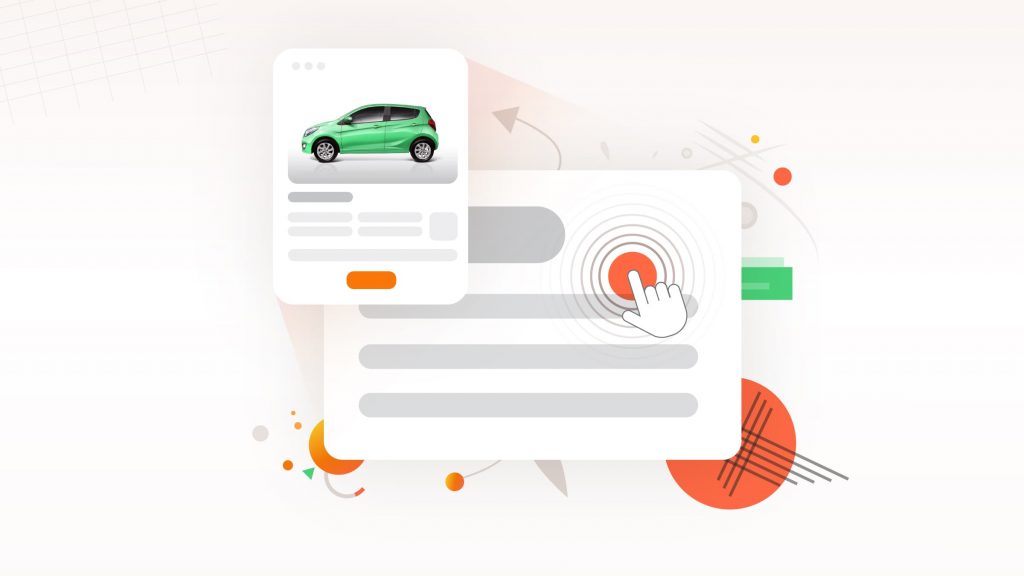Hello!
If your traditional marketing strategies aren't delivering the results you want for your automotive business, it's time to harness the power of automotive PPC (Pay-Per-Click) advertising.
 It's worth noting that 46% of clicks go to the top three paid ads on the search results page.
It's worth noting that 46% of clicks go to the top three paid ads on the search results page.
Given that most search results are organic, paid advertising provides a significant advantage in achieving visibility on Google. If you're aiming to enhance your automotive marketing efforts, PPC advertising must be your go-to strategy.
PPC marketing has evolved significantly over the years, and 2025 promises to bring even more innovations to the table. Automotive companies are increasingly turning to PPC to drive targeted traffic and conversions, thanks to its precision targeting capabilities and measurable ROI.
Key Trends Shaping Automotive PPC Marketing in 2025
Here are some key trends influencing automotive PPC marketing in 2025.
#1. Video Ads Domination
Video content continues to dominate the digital landscape, and automotive PPC is no exception. In 2025, expect to see more automotive brands investing in video ads to showcase their latest models, features, and innovations. Video ads not only grab attention but also allow for a more immersive brand experience.
Videos enable automotive marketers to tell a story, evoke emotions, and create a deeper connection with the audience. This is particularly important in the automotive industry where buying decisions are often influenced by emotional factors.
 Video ads can effectively demonstrate the features, performance, and benefits of vehicles.
Video ads can effectively demonstrate the features, performance, and benefits of vehicles.
They can provide virtual test drives, show off safety features, and highlight innovative technologies, giving consumers a more immersive experience.
A significant advantage of videos is that they can be shared on multiple platforms (like YouTube, social media, and your own websites) which helps automotive brands reach a larger audience. This increases the likelihood of connecting with potential customers.
Video content tends to perform well in terms of SEO, helping automotive brands improve their organic search rankings. Moreover, videos are highly shareable on social media platforms, increasing brand visibility and driving traffic to dealership websites.
#2. Voice Search Optimization
More consumers are using voice-activated devices such as smartphones, smart speakers, and virtual assistants like Siri, Google Assistant, and Alexa to perform searches. Since voice recognition technology continues to improve, you can expect this trend to grow further.
Voice search queries tend to be more conversational and natural compared to text-based queries. Consumers are more likely to ask questions or use longer phrases when performing voice searches.
 Many voice searches are conducted with local intent, such as "car dealerships near me" or "auto repair shops in [city]." Optimizing PPC campaigns for voice search can help automotive brands capture local traffic and attract nearby customers.
Many voice searches are conducted with local intent, such as "car dealerships near me" or "auto repair shops in [city]." Optimizing PPC campaigns for voice search can help automotive brands capture local traffic and attract nearby customers.
Voice search queries often use longer, more specific keywords and phrases. Automotive PPC marketers can benefit by incorporating these long-tail keywords into their campaigns to target users with high purchase intent.
Voice search results often pull information from featured snippets, also known as position zero in search engine results pages (SERPs). Optimizing content to appear as a featured snippet can increase the chances of being selected as the voice search result.
Voice search lets consumers search for automotive products and services hands-free, which is convenient, especially while driving or multitasking. Optimizing PPC campaigns for voice search can enhance user experience and accessibility.
#3. AI-Powered Automotive Advertising
Artificial Intelligence (AI) is transforming automotive advertising (pay-per-click) by optimizing bids, targeting, and ad creatives in real time. In 2025, automotive marketers are expected to use AI to personalize ads based on user behavior and preferences, thereby improving engagement and conversion rates.
 AI-powered tools can generate and optimize ad creatives, headlines, and copy based on performance data and user engagement metrics. This helps in creating more compelling and relevant ads.
AI-powered tools can generate and optimize ad creatives, headlines, and copy based on performance data and user engagement metrics. This helps in creating more compelling and relevant ads.
AI can predict the performance of PPC campaigns and make recommendations for optimizations, such as adjusting targeting parameters, budget allocations, and ad placements.
AI algorithms can analyze large amounts of data in real time to adjust bids for keywords based on factors like competition, historical performance, and predicted outcomes.
#4. Hyper-Local Targeting
Geo-targeting and hyper-local PPC campaigns are gaining traction in 2024. Hyper-local targeting allows automotive marketers to focus their PPC ads on a very specific geographic radius, such as targeting users within a certain distance from a dealership or service center.
This precision ensures that ads are shown to potential customers who are most likely to visit or make a purchase.
 As mentioned in the previous section, many consumers conduct voice searches (and text searches as well) to find local automotive services, such as "car dealerships near me" or "auto repair shops in [city]."
As mentioned in the previous section, many consumers conduct voice searches (and text searches as well) to find local automotive services, such as "car dealerships near me" or "auto repair shops in [city]."
By targeting hyper-locally, automotive brands can capture users with local search intent and drive foot traffic to physical locations.
Local businesses can gain a competitive edge by targeting their immediate geographic area, especially in markets with intense competition. Hyper-local PPC campaigns can help automotive businesses stand out from larger, national competitors.
By focusing on local communities, automotive brands can build stronger relationships with customers and enhance brand loyalty. This can be achieved by promoting local events, special offers, and community involvement through PPC ads.
 Hyper-local targeting enables personalized automotive advertising messages that are tailored to the needs and preferences of consumers in specific localities. This can improve the relevance of ads and increase engagement and conversion rates.
Hyper-local targeting enables personalized automotive advertising messages that are tailored to the needs and preferences of consumers in specific localities. This can improve the relevance of ads and increase engagement and conversion rates.
Hyper-local targeting can lead to more efficient ad spend, as ads are displayed to users who are more likely to convert.
This reduces wasted impressions and improves the return on investment (ROI) of PPC campaigns.
Advances in location-based technologies and mobile devices allow for precise geo-targeting capabilities. Automotive marketers can leverage these technologies to deliver targeted ads based on a user's current location or proximity to a specific location.
#5. Integrated Omnichannel Strategies
Successful automotive PPC campaigns in 2025 will integrate seamlessly with other digital marketing channels, such as social media, email, and content marketing. This integrated approach ensures consistent messaging across all touchpoints and maximizes the impact of PPC efforts.
Omnichannel marketing allows automotive brands to provide a more personalized and cohesive experience to consumers. By integrating PPC campaigns with other channels, brands can engage with customers at various touchpoints in their buying journey, from initial awareness to post-purchase support.
Omnichannel strategies enable better targeting and segmentation of audiences. By leveraging data from multiple channels, automotive marketers can create more detailed customer profiles and deliver highly targeted PPC ads that resonate with specific audience segments.
 Consumers use different devices (smartphones, tablets, and desktop computers) to research and buy automotive products and services. Integrated omnichannel strategies ensure that PPC ads are optimized for each device, providing a seamless experience regardless of the device used.
Consumers use different devices (smartphones, tablets, and desktop computers) to research and buy automotive products and services. Integrated omnichannel strategies ensure that PPC ads are optimized for each device, providing a seamless experience regardless of the device used.
Omnichannel marketing allows for the integration of data from various channels into a single platform or dashboard.
This centralized view of data enables better analysis of campaign performance, attribution modeling, and optimization of marketing efforts.
By integrating PPC with other channels, automotive brands can increase their reach and frequency of exposure to potential customers. This repeated exposure across different channels can reinforce brand awareness and influence purchase decisions.
Integrated omnichannel strategies allow automotive marketers to adapt quickly to changes in consumer behavior and market trends. By spreading their marketing efforts across different channels, brands can lower the risks of depending on just one channel.
Best Practices for Automotive PPC Success in 2025
Optimize your automotive PPC strategy with these best practices for success in 2025.
#1. Data-Driven Insights
In 2025, data-driven insights are crucial for automotive PPC success for several reasons:
- Optimizing Ad Performance: Data-driven insights help in evaluating the performance of PPC ads in real time. Marketers can identify which ads, keywords, and targeting automotive marketing strategies are driving the most clicks, conversions, and ROI, and adjust their campaigns accordingly.
- Predictive Analytics: Advanced data analytics techniques, such as predictive modeling, can forecast future trends and behaviors of automotive consumers. This helps marketers anticipate market changes and adjust their automotive PPC marketing strategies proactively.
- Budget Allocation: Data-driven insights assist in optimizing budget allocation across different PPC campaigns and channels. Marketers can identify which campaigns are delivering the highest return on investment (ROI) and allocate budgets accordingly to maximize overall performance.
- A/B Testing and Experimentation: Data analytics facilitates A/B testing and experimentation with different ad creatives, landing pages, and calls-to-action. By measuring the performance metrics, marketers can determine which variations are more effective and refine their automotive marketing strategies.
- Attribution Modeling: Data-driven insights enable marketers to accurately attribute conversions and sales to specific PPC campaigns and channels. This helps in understanding the full impact of PPC advertising on the customer journey and making informed decisions about campaign optimization.
#2. Creative Ad Formats
Creative ad formats, such as carousel ads, video ads, and interactive ads, are visually compelling and can capture the attention of potential customers more effectively than traditional text ads.
 In a competitive market, creative ad formats help automotive brands stand out from competitors. Unique and eye-catching ads are more likely to attract clicks and engagement from users.
In a competitive market, creative ad formats help automotive brands stand out from competitors. Unique and eye-catching ads are more likely to attract clicks and engagement from users.
Some ad formats, like interactive ads or gamified ads, encourage user interaction. This engagement can increase ad effectiveness and lead to higher conversion rates.
Creative ad formats are usually designed to work well on many different platforms and devices, such as mobile devices and social media. This ensures that ads reach consumers wherever they are browsing.
Creative ad formats provide opportunities to incorporate clear and compelling CTAs that drive users to take action, such as visiting a dealership, scheduling a test drive, or downloading a brochure.
Memorable and visually appealing ads can improve brand recall and recognition among consumers. This can influence purchase decisions and build long-term brand loyalty.
#3. Conversion Optimization
 Let’s explore some tips for conversion optimization to help you achieve automotive PPC success in 2025:
Let’s explore some tips for conversion optimization to help you achieve automotive PPC success in 2025:
- Landing Page Optimization: Ensure that the landing pages where users are directed after clicking on PPC ads are optimized for conversions. This includes clear and compelling calls-to-action (CTAs), relevant and engaging content, and a user-friendly layout.
- Form Optimization: If lead generation is a goal, optimize the lead capture forms on landing pages. Keep forms simple and easy to fill out, and only request essential information. Consider using autofill features for a smoother user experience.
- Call Tracking: Implement call tracking to measure the number of phone calls generated from PPC campaigns. This helps in understanding how many leads and conversions are driven by calls and optimizing campaigns to increase call conversions.
- Conversion Tracking: Use conversion tracking tools, such as Google Ads conversion tracking or third-party analytics platforms, to monitor and analyze the performance of PPC campaigns. Track conversions accurately to understand which campaigns are delivering the best ROI.
- Remarketing and Retargeting: Implement remarketing campaigns to re-engage users who have previously visited your website or interacted with your PPC ads. Tailor ads to their interests and behavior to encourage them to convert.
- Speed and Performance: Ensure that your website and landing pages load quickly and perform well across devices. A slow-loading page can lead to higher bounce rates and lower conversion rates.
- Continuous Optimization: PPC campaigns should be continuously monitored, analyzed, and optimized based on performance data. Test new automotive marketing strategies and tactics to improve conversion rates and achieve better results over time.
#4. Mobile Optimization
 With more consumers using mobile devices, ensure that your automotive PPC campaigns are optimized for mobile platforms to maximize reach and engagement.
With more consumers using mobile devices, ensure that your automotive PPC campaigns are optimized for mobile platforms to maximize reach and engagement.
Ensure that landing pages are mobile-friendly and responsive. This means that the layout, content, and design of the landing pages should adapt and display correctly on various screen sizes and devices.
Mobile users expect pages to load quickly. Optimizing images, minimizing redirects, and leveraging browser caching are some techniques to improve loading times and reduce bounce rates.
Mobile users often have shorter attention spans. So, you must use brief and compelling headlines, bullet points, and images to communicate information quickly and effectively.
Mobile users are more likely to use voice search capabilities. So, incorporate long-tail keywords and conversational phrases into PPC campaigns to capture these queries.
 Choose ad formats that are suitable for mobile devices, such as responsive search ads, app promotion ads, and video ads optimized for mobile viewing.
Choose ad formats that are suitable for mobile devices, such as responsive search ads, app promotion ads, and video ads optimized for mobile viewing.
It's highly recommended to use analytics tools to track mobile-specific metrics, such as click-through rates (CTRs), bounce rates, and conversion rates. Analyze this data to identify areas for improvement and optimize campaigns accordingly.
#5. Adaptability and Innovation
Consumer behavior and preferences are constantly evolving. Automotive marketers need to stay informed about these changes and adapt their automotive PPC marketing strategies to meet new consumer expectations.
New advertising platforms and features are continuously introduced. Marketers should stay updated with these developments and innovate by testing new platforms or leveraging new features that align with their goals.
 By adapting and innovating, marketers can sustain long-term growth in their PPC efforts. Continuous improvement and innovation help to maintain campaign effectiveness and achieve sustainable ROI.
By adapting and innovating, marketers can sustain long-term growth in their PPC efforts. Continuous improvement and innovation help to maintain campaign effectiveness and achieve sustainable ROI.
Marketers should collaborate with cross-functional teams and industry experts to share insights and best practices. Continuous learning and knowledge-sharing contribute to ongoing innovation in automotive PPC marketing.
Wrapping Up
It is quite obvious that automotive PPC marketing is set to become even more dynamic and influential in 2024. By implementing the proactive and innovative approaches mentioned in this post, automotive brands can achieve greater engagement, conversions, and ROI from their PPC efforts.
These approaches will not only improve campaign performance but will also ensure that automotive brands are effectively reaching and connecting with their target audience in 2025 and beyond. You can also consider hiring an established PPC agency to optimize and manage your campaigns.
Thank you!
Join us on social media!
See you!






